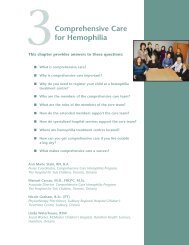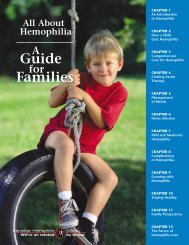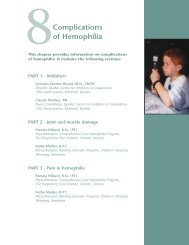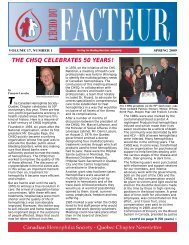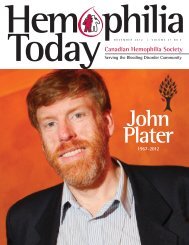Download
Download
Download
- No tags were found...
You also want an ePaper? Increase the reach of your titles
YUMPU automatically turns print PDFs into web optimized ePapers that Google loves.
HEMOPHILIA TODAY PHYSICAL FITNESSSUMMER 2002AND BLEEDING DISORDERS17Fitness Training,Trainers and theHemophiliacMichael DunbarCertified Fitness Leader (ResistanceTraining), WinnipegEditor’s note: As a first choice, we alwaysrecommend consultation with thephysiotherapist at your HemophiliaTreatment Centre. However, we know thatthis may not be possible in certain areas ofthe country. The treatment centre may be along distance from where you live, or thephysiotherapist may not have enough timeallocated during clinics to providepersonalized fitness consultation. Analternative to consider is a certified trainer.While the trainer has knowledge andexpertise in fitness training principles, it isunlikely that he or she will be familiar withhemophilia. We recommend strongly thatyou and your trainer stay in close contactwith the hemophilia treatment team.Fitness Training, Strength Training,Resistance Training, Weight Trainingand Body Building are all terms thatare often used interchangeably but, in fact,have slightly different meanings.Body Building, which can berecreational or competitive, focuses ondeveloping lean muscle mass beyond whatmost people would consider to be the“normal” limits of muscular development.This is a high-risk activity because of theheavy weight lifting required and onewhich hemophiliacs probably ought not toconsider.Weight Training focuses on developinglean muscle mass to what might beconsidered a more “normal” musculardevelopment, and makes use of acombination of machines and free weights.Resistance Training and Strength Trainingfocus on using a variety of static(motionless) and dynamic (moving)exercises to increase both muscularstrength and endurance. Weight Training,Resistance Training and Strength Trainingare all well within the capabilities of thehemophiliac. Fitness Training combinesWeight, Resistance and Strength Trainingprinciples and adds components that willhelp to decrease the percentage of body fat,increase the rate at which the body burnscalories, and improve the cardio-vascularsystem. It is probably Fitness Training thatwill provide the most benefits for mostpeople.Why Fitness Training?As Kathy mentioned in her editorial,North Americans are plagued with theproblems associated with poor- and overeatingand under-exercising. A wellplannedFitness Program can help to arrestand even reverse many of these problems.Cardio-vascular components of a FitnessProgram can help in the treatment ofatherosclerosis by stimulating blood-flow,hence helping to scour the arteries ofdangerous plaque. Greater heart efficiencyis also a result. Fat-burn programs are selfexplanatory.Reducing the percentage ofbody fat improves general health. Ellipticaltraining machines are safe and virtuallyimpact-free, helping to preserve theintegrity of ankle, knee and hip joints,making them ideal for hemophiliacs.Weight, Resistance and StrengthTraining (WRST) have many benefits forthe general population, and hemophiliacsin particular. Probably the greatest benefitderived from these types of training isimproved proprioception—the body’sability to judge where it is in space.Improved proprioception will result infewer stumbles, trips, knocks, bumps andfalls. Learning to manipulate weights trainsthe brain to help you negotiate the curbs,sharp corners and other hazards that cancause bleeds. Preventing further injury iscritical to your well-being and improvedproprioception will help in thatprevention.The second benefit that accrues fromWRST is an increase in bone density. Foryears, we’ve been hearing about thedangers of osteoporosis to women as theyage. Recent research indicates that men areequally at risk. Weight-bearing exercisesresult, almost immediately, in an increasein bone density.The third benefit is increased bloodflow,surely an irony for the hemophiliac.But increased blood-flow helps to repairdamaged tissue. As long as the exercise isimpact- and injury-free, tendons, muscles,cartilage and bone will receive the healingbenefit of increased blood-flow.A fourth benefit of WRST is increasedstrength for the activities of daily living(ADL). Simple things like pushing alawnmower or lifting groceries from theback seat of the car can be potentiallydangerous if we don’t have the requisitemuscular strength.A fifth—and by no means last—benefitof WRST is the release of endorphins thatcome with physical activity. You just feelbetter!Why a Trainer?A certified trainer can and will help youto train safely. S/he will provide you withsafe and proper techniques to help youtrain efficiently and effectively. S/he willshow you exercise routines that you can doin your own home with minimalequipment. Thera-Bands and Swiss ballscan be used at home or in the gym. Yourtrainer will also be able to introduce you tothe appropriate safe and effective machinesand weights at a gym at which you feelcomfortable. S/he will be able to modifyexercises to accommodate your individualneeds. If you have a reduced range-ofmotionin a particular joint, your trainerwill be able to show you how to deal withthat and still get maximum results fromthe exercise. Your trainer, knowing yourmedical condition, will understand thatyou cannot do certain things —”one-repmax”,ballistic movements for example—and will find things for you to do that willmake your workouts productive andrewarding. And your trainer will help youhave fun doing all this!To find a certified trainer in your area,contact your local Recreation and ParksAssociation/Fitness Council, the NationalFitness Leadership Alliance or the NationalFitness Leadership Advisory Council.Michael Dunbar is a Certified Fitness Leader(Resistance Training) in Winnipeg,Manitoba. He works out and trains clients atFitness City. He can be reached by email atmdunbar@merlin.mb.ca



